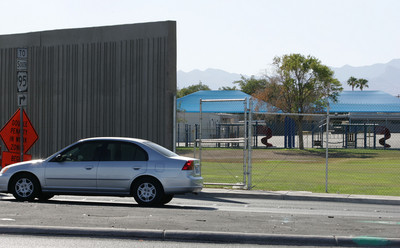That odor is highway construction
Not long ago, the widening of U.S. Highway 95 was stalled in the northwestern Las Vegas Valley as a legal fight swirled around one central question: How safe will the widened road be for people's lungs?
Not very safe, contended the Sierra Club, which filed a lawsuit to stop the work. It claimed health risks to people living near U.S. 95 were not adequately considered before the plan was green-lighted.
Nonsense, said local, state and federal officials backing the road plan. Everything that could have been done had been done, taking into consideration the science available at that time.
"We do not think people are at risk today," Mary Peters, then the head of the Federal Highway Administration, said two years ago.
"What we do think is we don't have the information to make a determination on this issue," she said.
That was then. Now, with the lawsuit settled out of court and the widened freeway set to open new lanes before year's end, the science may have finally caught up to the question.
And the latest news may make you want to hold your breath if you're within shouting distance of U.S. 95.
A recent study, by the University of Southern California's Keck School of Medicine, found that kids living within one-third of a mile of a freeway since the age of 10 had "substantial deficits" in lung function by the age of 18, when compared to kids living at least one mile from an expressway.
The New York Times termed it a "landmark" study and the largest examination of air pollution health effects ever undertaken.
It was not just the sick that suffered lung deterioration, according to the study.
"Otherwise-healthy children who were nonasthmatic and nonsmokers also experienced a significant decrease in lung function from traffic pollution," W. James Gauderman, the study's lead author and an associate professor at USC's Keck School, said in a prepared statement. "This suggests that all children, not just susceptible subgroups, are potentially affected by traffic exposure."
The study was completed earlier this year and also funded in part by the U.S. Environmental Protection Agency, the California Air Resources Board and other health groups.
The study drew its findings from data collected from nearly 4,000 children living in Los Angeles-area communities like Anaheim, San Bernardino and Riverside, places not too different in topography and environment from the Las Vegas Valley.
"This study shows there are health effects from childhood exposure to traffic exhaust that can last a lifetime," David A. Schwartz, director of the National Institute of Environmental Health Sciences -- which also partially funded the study -- said in a prepared statement.
Gauderman hopes that the research will influence community planners and developers to be careful when picking where to put new homes, schools and highways.
"The study provides further proof that regional air quality regulations may need to be adjusted based on local factors, including traffic volume," Gauderman said.
"This is important because in areas where the population continues to grow, more and more children are living or attending school near busy roadways. This may be harmful in the long run."
Especially in the case of U.S. 95, where three schools -- Western High School and Fyfe and Adcock elementary schools -- are well within a mile of new lanes.
Still, officials at the Nevada Department of Transportation, which is widening U.S. 95, say the study wouldn't have altered their approach to fattening the freeway.
Highway planners say jammed, idling traffic on the overburdened freeway is more of a pollution-generator than free-flowing cars and trucks.
"We're reducing the amount of congestion. When you have congestion, you have more idling," said Scott Magruder, a Transportation Department spokesman. "The idling adds more pollution.
"We feel strongly it (the widening) lessens the amount of pollution. If you're in the car for 15 minutes instead of 30 minutes, you're putting less pollution in the air."
To see if that is so, the Transportation Department, as part of its 2005 settlement with the Sierra Club, has set up air monitoring stations along U.S. 95 to see what sort of impact the new lanes will have on air quality.
Also included in the settlement were the installation of air filtration and monitoring equipment at the three nearby schools; relocation of a playground and three mobile classrooms away from the freeway; and the tweaking of a rebuilt Western to minimize pollution impact on students.
Will the study change how the Transportation Department lays out roads in the future? Authorities aren't sure.
"What's the solution? Do you just put in a buffer zone between homes and highways?" Magruder asked. "That would be something that would be discussed. The downside of that is it would be very costly" to buy excess land for such a zone.
So what will it be, Silver Staters? Your kid's lungs or your car's lanes?
If you have a question, tip or tirade, call the City Desk at 383-0264, or send an e-mail to roadwarrior@reviewjournal.com. Please include your phone number.
ROAD WARRIORMORE COLUMNSDiscuss this column in the eForums!
Beginning Tuesday through at least Friday, drivers can expect lane reductions on northbound Nellis Boulevard around Bonanza Road to allow underground sewer work. Through at least Oct. 5, drivers can expect lane reductions on Nellis Boulevard between Cheyenne Road and Gowan Road to allow underground sewer work. Drivers can expect delays and lane shifts.























